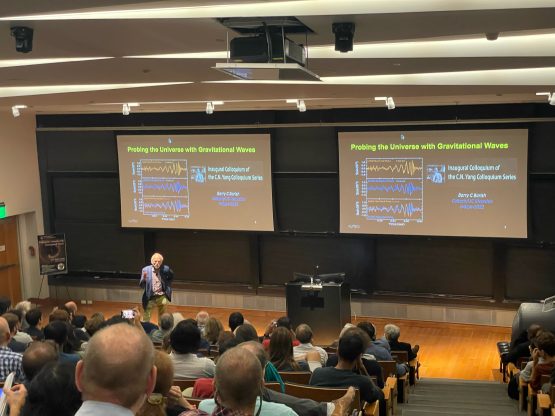
On Tuesday, Sept. 6, Nobel Prize winner in Physics Dr. Barry Barish spoke as the inaugural featured speaker of the newly established C.N. Yang Colloquium series in the Department of Physics and Astronomy.
In 2017, Barish was awarded the Nobel Prize in Physics for his research on the observation of gravitational waves with the historic Laser Interferometer Gravitational-Wave Observatory (LIGO) experiment. His work scientifically proved the existence of ripples in the fabric of space and time, which was predicted by Albert Einstein in 1915.
The lecture took place in the Della Pietra Family Auditorium in the Simons Center for Geometry and Physics. After serving refreshments to an audience of approximately 200 people, Chang Kee Jung, a distinguished professor and the physics department chair at Stony Brook University, introduced Barish to the audience.
Barish is the Ronald and Maxine Linde Professor of Physics, Emeritus, at the California Institute of Technology (Caltech). In Fall 2023, Barish will be joining Stony Brook University as the inaugural President’s Distinguished Endowed Chair in Physics.
Dzmitry Dudko, an assistant professor in the department of mathematics at Stony Brook, attended the lecture.
“I love astronomy. I follow the news about it. It’s something that interests me a lot and I’m at the point where the usual news is boring to follow,” Dudko said about his motivation to attend.
Barish began the discussion by introducing the audience to his work studying gravitational waves, defining what they are and where they come from.
According to Einstein’s theory of general relativity, as two black holes begin to merge, they encircle one another. Their interaction creates distortions in space-time, which are known as gravitational waves. The energy that is released by these waves is 50 times stronger than anything else in the observable universe.
Einstein theorized that after their creation, gravitational waves take about a billion years to reach Earth, where they are then stretched and squeezed through space.
The Laser Interferometer Gravitational-Wave Observatory, otherwise known as the LIGO detector, was created by Barish and his team to study the existence of these gravitational waves beginning in the 1970s.
A LIGO detector contains two light beams, traveling in perpendicular tubes slightly adjacent from each other. Experiments done with these beams allowed Barish and his coworkers to confirm the existence of gravitational waves for the first time.
According to Einstein’s theory, gravitational waves behave like ripples in four-dimensional space-time. Barish’s experiments helped prove this theory and allowed him and his team to develop a method that allows researchers to directly see and observe black holes.
“It was exciting hearing what a Nobel prize winner had to say,” Ariel Vuolo, a Stony Brook undergraduate student studying physics and biology, said. “I would definitely come back to his talks. From today’s lecture, I learned how gravitational waves are detected and how long the process was.”
Beginning in the 1970s, Barish played a crucial role in the project and significantly influenced the detection of gravitational waves with the use of the LIGO detector. The first gravitational wave detection occurred in 2015 — 45 years after he started his work.
During his lecture, Barish gave some words of advice to aspiring scientists like Vuolo. “This is fun for me. It’s fun whether we find something or just solve problems. It took us a long time to do this, but it was a lot of fun,” Barish said. “To fix and find all the problems, I’m lucky people pay me. I get up and spend my day solving problems. That’s great. If you’re not having any fun, don’t do it.”










